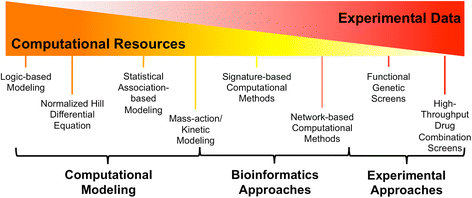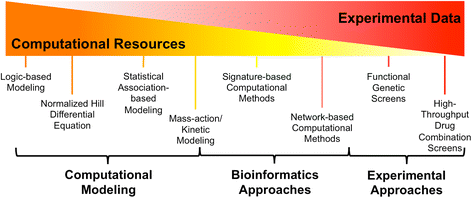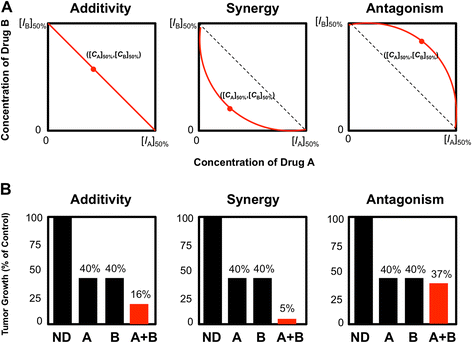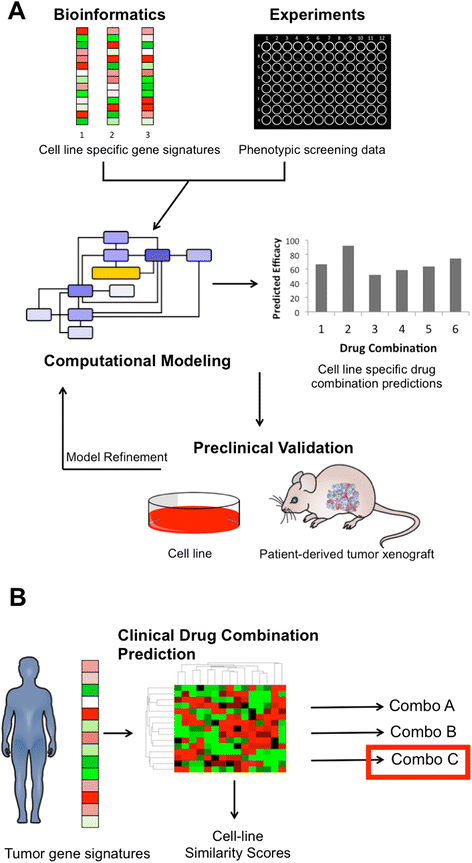Systems biology approaches for advancing the discovery of effective drug combinations
- PMID: 25741385
- PMCID: PMC4348553
- DOI: 10.1186/s13321-015-0055-9
Systems biology approaches for advancing the discovery of effective drug combinations
Abstract
Complex diseases like cancer are regulated by large, interconnected networks with many pathways affecting cell proliferation, invasion, and drug resistance. However, current cancer therapy predominantly relies on the reductionist approach of one gene-one disease. Combinations of drugs may overcome drug resistance by limiting mutations and induction of escape pathways, but given the enormous number of possible drug combinations, strategies to reduce the search space and prioritize experiments are needed. In this review, we focus on the use of computational modeling, bioinformatics and high-throughput experimental methods for discovery of drug combinations. We highlight cutting-edge systems approaches, including large-scale modeling of cell signaling networks, network motif analysis, statistical association-based models, identifying correlations in gene signatures, functional genomics, and high-throughput combination screens. We also present a list of publicly available data and resources to aid in discovery of drug combinations. Integration of these systems approaches will enable faster discovery and translation of clinically relevant drug combinations. Graphical abstractSpectrum of Systems Biology Approaches for Drug Combinations.
Keywords: Cancer; Computational modeling; Drug combinations; Drug discovery; Systems biology.
Figures




Similar articles
-
DrugComboRanker: drug combination discovery based on target network analysis.Bioinformatics. 2014 Jun 15;30(12):i228-36. doi: 10.1093/bioinformatics/btu278. Bioinformatics. 2014. PMID: 24931988 Free PMC article.
-
Computational systems approach for drug target discovery.Expert Opin Drug Discov. 2009 Dec;4(12):1221-36. doi: 10.1517/17460440903380422. Expert Opin Drug Discov. 2009. PMID: 23480463
-
Synergy from gene expression and network mining (SynGeNet) method predicts synergistic drug combinations for diverse melanoma genomic subtypes.NPJ Syst Biol Appl. 2019 Feb 26;5:6. doi: 10.1038/s41540-019-0085-4. eCollection 2019. NPJ Syst Biol Appl. 2019. PMID: 30820351 Free PMC article.
-
Predictive approaches for drug combination discovery in cancer.Brief Bioinform. 2018 Mar 1;19(2):263-276. doi: 10.1093/bib/bbw104. Brief Bioinform. 2018. PMID: 27881431 Free PMC article. Review.
-
High-throughput methods for combinatorial drug discovery.Sci Transl Med. 2013 Oct 2;5(205):205rv1. doi: 10.1126/scitranslmed.3006667. Sci Transl Med. 2013. PMID: 24089409 Review.
Cited by
-
Systematic Analysis of Quantitative Logic Model Ensembles Predicts Drug Combination Effects on Cell Signaling Networks.CPT Pharmacometrics Syst Pharmacol. 2016 Oct;5(10):544-553. doi: 10.1002/psp4.12104. Epub 2016 Aug 27. CPT Pharmacometrics Syst Pharmacol. 2016. PMID: 27567007 Free PMC article.
-
Machine Learning for Integrating Data in Biology and Medicine: Principles, Practice, and Opportunities.Inf Fusion. 2019 Oct;50:71-91. doi: 10.1016/j.inffus.2018.09.012. Epub 2018 Sep 21. Inf Fusion. 2019. PMID: 30467459 Free PMC article.
-
Cyclooxygenase-2 Upregulated by Temozolomide in Glioblastoma Cells Is Shuttled In Extracellular Vesicles Modifying Recipient Cell Phenotype.Front Oncol. 2022 Jul 22;12:933746. doi: 10.3389/fonc.2022.933746. eCollection 2022. Front Oncol. 2022. PMID: 35936755 Free PMC article.
-
Sensitivities of three tropical indigenous freshwater invertebrates to single and mixture exposures of diuron and carbofuran and their commercial formulations.Ecotoxicology. 2018 Sep;27(7):834-844. doi: 10.1007/s10646-018-1921-9. Epub 2018 Apr 20. Ecotoxicology. 2018. PMID: 29679314
-
Artificial intelligence and machine learning methods in predicting anti-cancer drug combination effects.Brief Bioinform. 2021 Nov 5;22(6):bbab271. doi: 10.1093/bib/bbab271. Brief Bioinform. 2021. PMID: 34347041 Free PMC article. Review.
References
Grants and funding
LinkOut - more resources
Full Text Sources
Other Literature Sources

